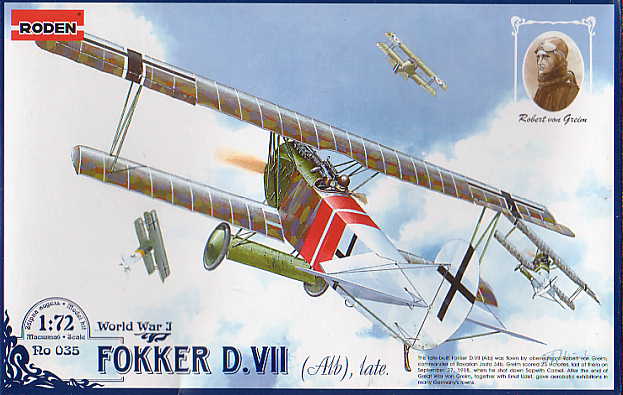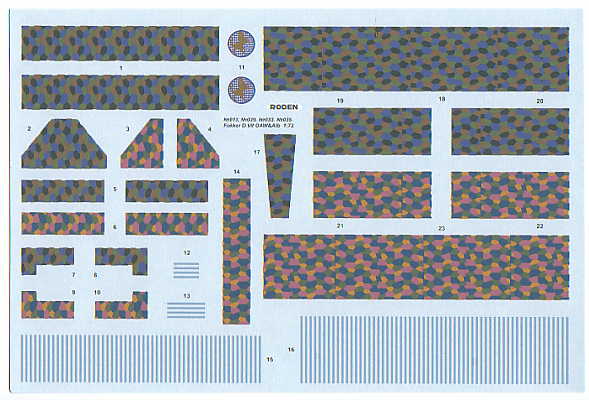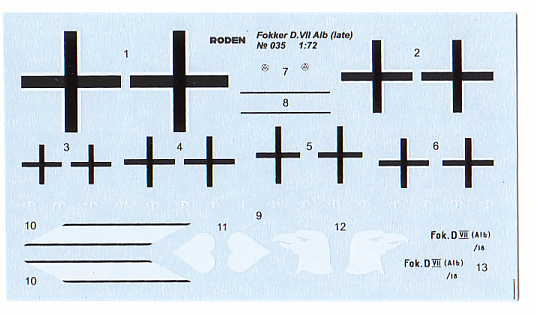|
Fokker D.VII (Alb), Late

Roden

Roden's 1/72
scale Fokker D.VII is available online from Squadron.com
S
u m m a r y
|
| Catalogue Number: |
Kit No. 035 |
| Scale: |
1/72 |
| Contents and Media: |
60 grey plastic parts; markings for
five options including lozenge decals |
| Price: |
USD$8.96 from
Squadron.com
|
| Review Type: |
FirstLook |
| Advantages: |
Well researched, accurate detail,
useable lozenge |
| Disadvantages: |
Some fit problems, extra clean up of
parts needed |
| Recommendation: |
Recommended |
Reviewed by Robert Baumgartner
Roden have released another version of their series on the Fokker D.VII.
This time it is in the form of the license built aircraft manufactured by
Albatros.
The Sprues
Molded in the usual light gray plastic, there are four sprues labeled
A, B, H and Z containing a total of 60 parts. Most items are familiar from
previous releases but the new H sprue has the fuselage halves appropriate
for the Albatros built version plus a new radiator. Again the spare parts
box wins with Roden supplying three types of propeller, two different
engines, exhausts and a collection of machine guns.
Flash is present on some parts, but this is easily removed by light
sanding.
Click the thumbnails below
to view larger images:
Accuracy
As expected, the kit scales out well with Ian Stairs plans in Datafile
9 and the Fokker D.VII Anthology series, both published by Albatros
Productions. The only major discrepancy is the span of the undercarriage
airfoil wing, which is significantly undersize. Padding one end with
plastic card and reinstating the axle will solve this. Some many even
chose to slightly reduce the fuselage length.
Wings
The trailing edges of the flying surfaces are commendably thin but
could also do with some sanding to redefine their shape. The blemish on
the lower port wing of previous releases is still there and requires some
careful treatment to remove. This is not hard to do, it just means a few
more minutes sanding. The upper wing has the correct tapering towards the
tips but a slight dihedral has to be removed by gentle bending in hot
water.
The molding of items such as the struts is as true to scale as Roden’s
injection process will allow. So delicate are they that removing these
parts from the sprue will inevitably lead to breakage unless one is very,
very careful.
Fuselage
The fuselage halves are well molded with a very subtle representation
of the interior structure showing through. There is an abundance of
louvers on the engine panels and the modeler is asked to shave off the
extras that don’t apply to the subject they are building. This is a good
idea as it keeps costs down on molding different “front ends” and also
allows other Albatros built subjects to be made apart from the
kit-supplied options.
Assembly will not be trouble free if the previous D.VII variants are
anything to go by, but a little patience will reward. These are the areas
to look out for:
-
The engine will need careful adjustment to
make it fit in the proper position between the fuselage halves.
-
Cut the lower wing in half to allow it to
fit in the slot under the fuselage halves and then fill the gaps with
putty and sand smooth.
-
The forward cockpit deck is slightly short
and will benefit from shimming and filling.
Roden have been very imaginative in their chose of aircraft. Five
machines are catered for on two well-printed decal sheets. One of these
sheets contains both upper and lower 4-color lozenge as well as rib tapes,
the other has the crosses and personal markings.

It is pleasing to see that this manufacturer has been listening to the
public because we finally have lozenge in colors that resemble those of
the original. The rib tapes though, are too wide and so will have to be
cut in half and the register on the insignias was a little off on my
example.
The five represented machines are:
-
Fokker D.VII flown by Oblt. Robert von
Greim of Jasta 34b, 1918
Roden simplify the color mixing by suggesting matt light gray for the
rear fuselage areas, but the Jasta color was more accurately a silvery
white.
The cowling, struts, and wheels were finished in greenish grey rather
than the quoted marine green.
-
Fokker D.VII flown by Ltn. Kithil of Jasta
34b, September 1918
As above.
-
Fokker D.VII flown by Putz of Jasta 34b,
September 1918
As above.
-
Fokker D.VII flown by Ltn. Frodien of Jasta
40, 1918
-
Fokker D.VII flown by Willi Rosenstein of
Jasta 40, 1918
Photographic evidence suggests that the upper wing stripe is on the port
side.

The louver patterns on Fokker D.VIIs are a study in themselves so it is
a brave person who can state which patterns are applicable to which
aircraft. Clear photos of both port and starboard areas are rare so an
educated guess is called for. Builders are reminded to make up their own
minds by viewing as many photos as possible of the chosen subject or other
aircraft that flew in the same unit at that time.
I find options (4) and (5) especially interesting as these machines have
been photographed with the upper engine cowls removed. This provides the
perfect opportunity to show off the lovely engine that is provided in the
kit. Roden have also thought of this and indicate where to apply the
scalpel in the instruction sheets.
Overall this is another well-researched kit with accurate
detail and excellent decals.
A little cleaning up of the parts and careful assembly
will result in a pleasing version of a much-neglected version of the
Fokker D.VII.
Thanks to
Squadron.com for the review
sample.
Review and Images Copyright © 2002 by
Robert Baumgartner
Page Created 02 April, 2002
Last updated 22 July, 2003
Back to HyperScale Main Page
Back to Reviews Page
|
Home | What's
New | Features
| Gallery |
Reviews | Reference
| Forum
| Search